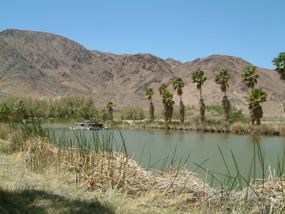Three new research projects came out of the 2003 workshop.
1) A Master's Thesis project is underway at California State University-Fullerton and the Desert Studies Consortium censusing populations at Lake Tuendae, MC Spring (these two count as one population in the Recovery Plan), China Lake Naval Air Weapons Station, and Camp Cady.
2) An investigation of the effects of Asian Tapeworm (Bothriocephalus achelognathii), a cestode parasite discovered when Lake Tuendae was dredged in 2001, is being conducted by the Arizona Cooperative Fish and Wildlife Research Unit in Tucson, Arizona.
3) A study of species interactions and ecology of Lake Tuendae is being conducted by North Dakota State University with attention to the establishment of new population refuges.
Research results will be posted on this webpage when completed.
Archdeacon, T. P., and S. A. Bonar. 2006. Techniques for laboratory spawning of Mohave tui chub, Desert Fishes Council 38th Annual Meeting, Death Valley, California.(presentation)
Archdeacon, T. P., 2007. Effects of Asian Tapeworm on Mohave Tui Chub. Final Thesis Presentation.
Archdeacon, T. P., 2007. Effects of Asian Tapeworm, Mosquitofish, and Food Ration on Mohave Tui Chub Growth and Survival, Master's Thesis, School of Natural Resources, The University of Arizona, 77p.
Chen, Y., S. Parmenter, and B. May. 2006. Genetic structure and management history of Mohave tui chub, Desert Fishes Council 38th Annual Meeting, Death Valley, California.(presentation)
Henkananththegedara, S. and C. Stockwell. 2006. Biotic evaluation of Mohave tui chub habitats: Lake Tuendae and MC Pond, Mojave National Preserve, Desert Fishes Council 38th Annual Meeting, Death Valley, California.(presentation)

